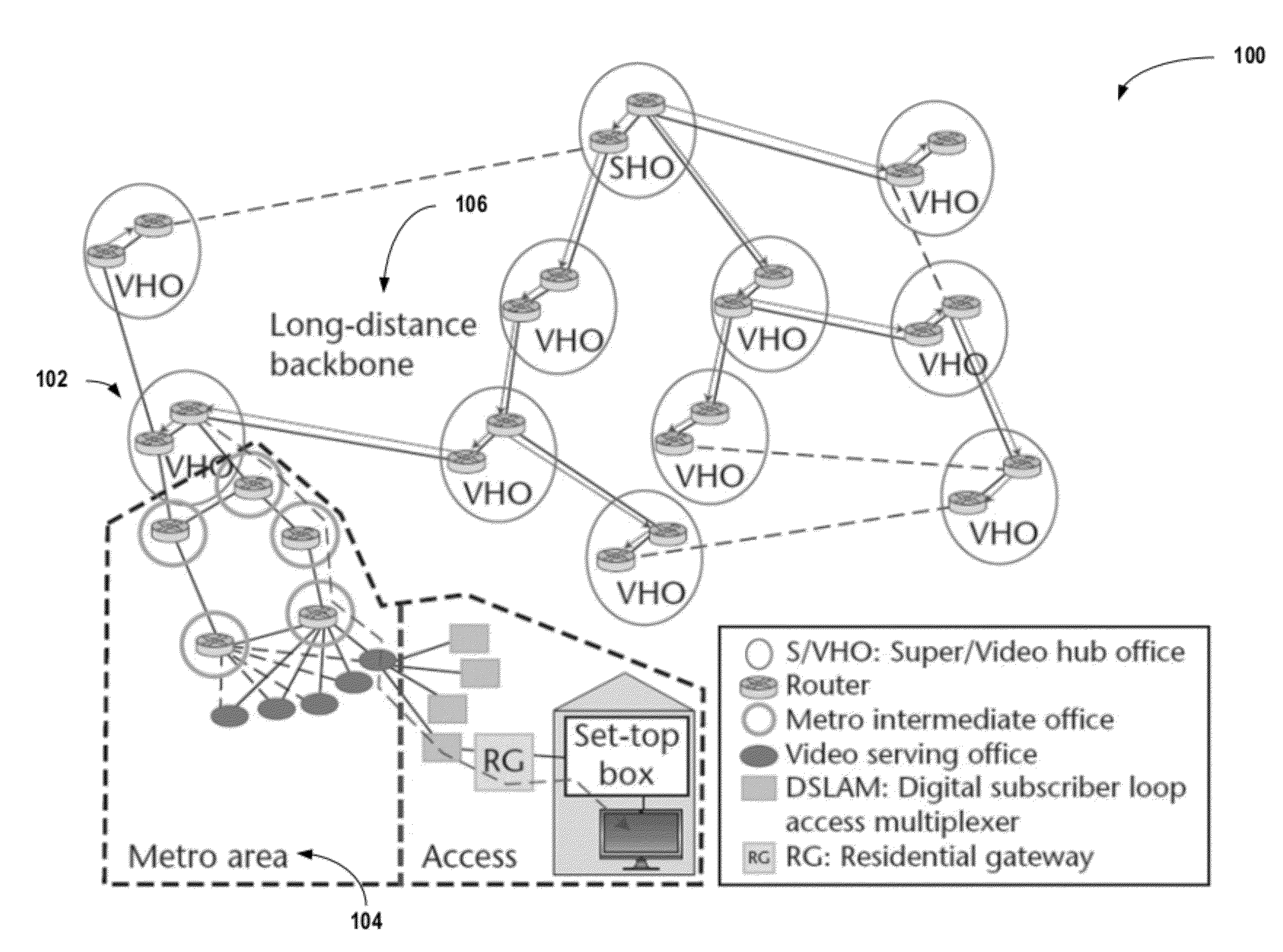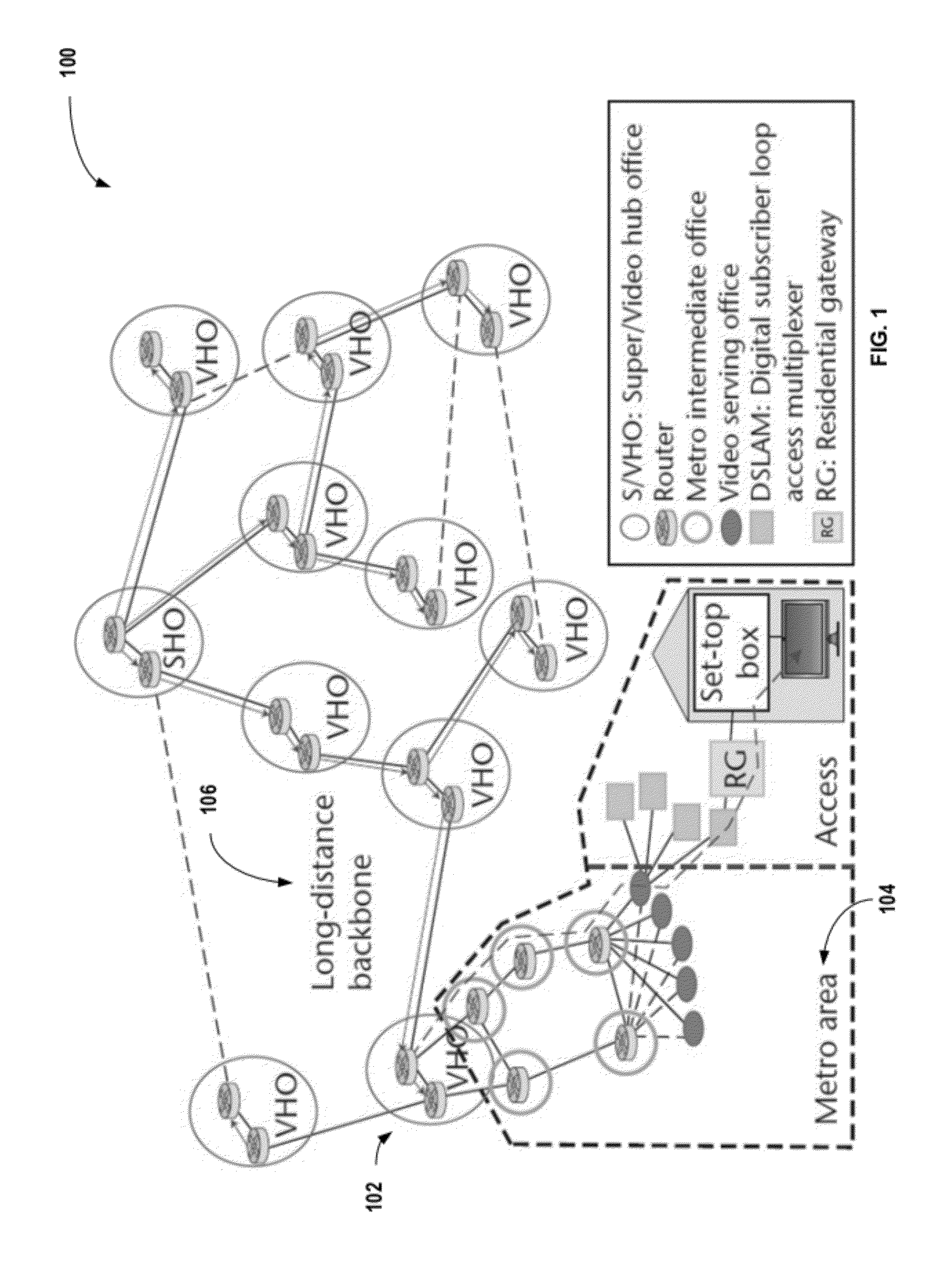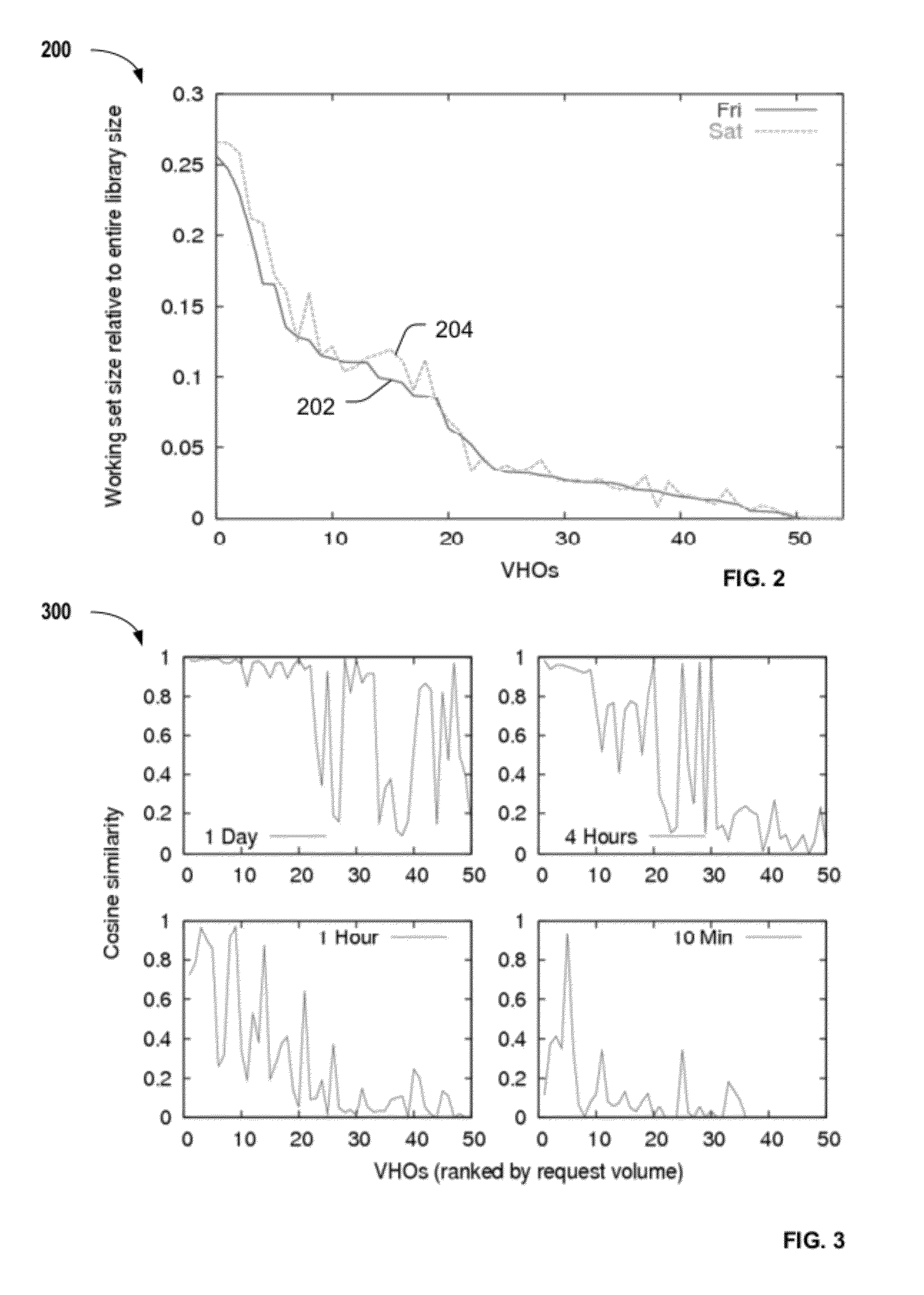With the rapid increase in library sizes, it may become burdensome or infeasible to replicate the entire library at each metropolitan office.
Despite
disk space being plentiful and affordable, replicating the entire library at each VHO may be economically burdensome or infeasible.
The rate of creation of content, the ever-increasing demand for high-quality content (e.g., high-definition, 3-D video), and the space needed to store the content appears to be outpacing the ability of providers to economically add storage and replicate content at each office.
Content placement may be challenging and using simple cache replacement policies alone may not suffice.
Multiple studies have observed “long
tail” properties in the popularity of videos, meaning that a large number of videos are requested infrequently.
Hence, storing copies of these videos in all locations may be considered overkill.
A
cache miss may impose a significant burden on the
system in the context of VoD, as the
cache miss results in transfer of a high-bandwidth
stream from a remote location / node for an extended period of time.
Further, a video being viewed may be retained in the cache for the length of the video, thereby occupying the cache for a long period.
As described below, the
working set size can be quite large in typical VoD deployments and may change over time.
However, many existing schemes are based on simplifying assumptions that may be unrealistic (e.g., same demand pattern from all locations), rely on a particular class of networks (e.g., tree topology), or use
heuristics to make the problem tractable.
Also, many existing schemes do not consider link capacity constraints, which may be an important aspect in delivering high-quality videos for an extended period of time.
Without link bandwidth constraints, the problem is a facility location problem.
Adding bandwidth constraints introduces the aspect of multicommodity flow, which can make the models computationally more difficult.
However, due to the scale of the problem, even
linear programming (LP) relaxation of the MIP may be too large for off-the-shelf
software to find an optimal solution within a reasonable time.
This, however, may only enable prediction of demand for videos already in the library.
Results indicate that the disclosed approach may outperform existing caching schemes.
A simple LRU cache replacement policy may not be adequate, and such a cache replacement policy may have an
adverse effect on the miss ratio.
While the request mix may be similar across days, there may be significant differences in the request mix as the time window size decreases.
While the values of α and β may, in practice, take into account the monetary cost of storing and transferring the video, as explained below, the actual values do not affect which solution is optimal with respect to this model.
However, incremental updates to implement a new solution can potentially incur considerable cost.
Although LPs can be solved in polynomial time, the instances may be too large to solve efficiently even with a state-of-the-art commercial LP
solver.
This causes the LP to decompose into multiple independent (fractional) uncapacitated facility location problems, one for each video.
This MIP for
rounding video m is an (integer) uncapacitated facility location problem with piecewise-linear costs.
Also, although there is no guarantee for the performance of this
rounding heuristic, it only leads to around 1-2% overage for disk, link bandwidth, and the objective when compared to the fractional solution for the instances studied.
Further, many such newly added videos may receive a significant number of requests.
While TV shows and blockbuster movies account for the majority of requests for new videos—series episodes typically account for more than half of the requests for new releases—there may not be a demand estimate that is available for the remaining new videos (e.g., music videos, unpopular movies, etc.).
If a small time window is selected to compute load, the representative load may not be captured and hence videos may not be placed appropriately.
While updating the placement more frequently allows the
system to adapt to changing demands and correct for
estimation errors more gracefully, each update incurs overhead, both in computing the new MIP solution and migrating the content.
Due to the local cache replacement in all the alternative approaches, if a VHO does not have a local copy of a requested video, it may be difficult in practice for the VHO to find which VHO is best to fetch the video from.
This is because each week introduces new videos, some of which may not have a good estimate.
With the Top-100 videos occupying significant storage, there is less space for the LRU cache, and hence the performance becomes worse.
This is to avoid remotely fetching frequently requested videos, which not only increases the overall cost (i.e.,
byte transfer), but also leads to link capacity violations.
However, in the present solution, even highly popular videos are not replicated everywhere (e.g., less than 30 VHOs have a copy of the 10th most popular video).
A given movie may need only a few copies—anywhere from 2 copies to 10 copies—but together these videos consume significant space.
Unfortunately, caching schemes may have difficulty dealing with medium popular videos 704, unless the cache size is sufficiently large.
As a result, almost 20% of the requests could not be cached locally, with around 60% of requests being served by remote offices.
This is because the MIP solution considers the link constraints only during the 1-second window, and due to a highly varying request mix, the request pattern during the window is not representative.
As a result, the placement solution is not able to satisfy the link constraint outside of the window.
Thus, 1-day windows lead to a significant over-
estimation of the required link bandwidth.
However, each iteration incurs computational and transfer overheads.
This is because with less frequent updates, the error in
demand estimation accumulates over time, as the current placement does not adapt to changes in the demand pattern.
Compared to weekly updates, daily updates only modestly improve the maximum bandwidth usage or miss ratio.
On the other hand, without any
estimation for new videos, the maximum bandwidth grows to over 8+ times the link capacity, and the resulting placement results in multiple remote transfers.
Additionally, the illustrations are merely representational and may not be drawn to scale.
 Login to View More
Login to View More  Login to View More
Login to View More 


